 R&D OVERVIEW
Michael Benjamin
24 September 2014
Exhibit 99.4 |
 R&D OVERVIEW
Michael Benjamin
24 September 2014
Exhibit 99.4 |
  DISCLAIMER
2
This Management Presentation contains forward-looking statements. James Hardie may from time to
time make forward-looking statements in its periodic reports filed with or furnished to the
SEC, on Forms 20-F and 6-K, in its annual reports to shareholders, in offering circulars, invitation memoranda and prospectuses, in media releases and other written
materials and in oral statements made by the company’s officers, directors or employees to
analysts, institutional investors, existing and potential lenders, representatives of the media
and others. Statements that are not historical facts are forward-looking statements and such
forward-looking statements are statements made pursuant to the Safe Harbor Provisions of
the Private Securities Litigation Reform Act of 1995.
Examples of forward-looking statements include: •
statements about the company’s future performance; •
projections of the company’s results of operations or financial condition; •
statements regarding the company’s plans, objectives or goals, including those relating to
strategies, initiatives, competition, acquisitions, dispositions and/or its products;
•
expectations concerning the costs associated with the suspension or closure of operations at any of
the company’s plants and future plans with respect to any such plants;
•
expectations concerning the costs associated with the significant capital expenditure projects at any
of the company’s plants and future plans with respect to any such projects;
•
expectations regarding the extension or renewal of the company’s credit facilities including
changes to terms, covenants or ratios;
•
expectations concerning dividend payments and share buy-backs; •
statements concerning the company’s corporate and tax domiciles and structures and potential
changes to them, including potential tax charges;
•
statements regarding tax liabilities and related audits, reviews and proceedings; •
statements regarding the possible consequences and/or potential outcome of the legal proceedings
brought against two of the company’s subsidiaries by the New Zealand Ministry of Education
and the potential product liabilities, if any, associated with such proceedings;
•
expectations about the timing and amount of contributions to Asbestos Injuries Compensation Fund
(AICF), a special purpose fund for the compensation of proven Australian asbestos-related
personal injury and death claims;
•
expectations concerning indemnification obligations; •
expectations concerning the adequacy of the company’s warranty provisions and estimates for
future warranty-related costs;
•
statements regarding the company’s ability to manage legal and regulatory matters (including but
not limited to product liability, environmental, intellectual property and competition law
matters) and to resolve any such pending legal and regulatory matters within current estimates and in anticipation of certain third-party recoveries; and
•
statements about economic conditions, such as changes in the US economic or housing recovery or
changes in the market conditions in the Asia Pacific region, the levels of new home
construction and home renovations, unemployment levels, changes in consumer income, changes or stability in housing values, the availability of mortgages and
other financing, mortgage and other interest rates, housing affordability and supply, the levels of
foreclosures and home resales, currency exchange rates, and builder and consumer confidence. |
 3
Words such as “believe,” “anticipate,” “plan,” “expect,”
“intend,” “target,” “estimate,” “project,” “predict,” “forecast,” “guideline,” “aim,” “will,” “should,” “likely,” “continue,”
“may,” “objective,” “outlook” and similar expressions are
intended to identify forward-looking statements but are not the exclusive means of identifying such statements. Readers are cautioned
not to place undue reliance on these forward-looking statements and all such forward-looking
statements are qualified in their entirety by reference to the following cautionary statements.
Forward-looking statements are based on the company’s current expectations, estimates and
assumptions and because forward-looking statements address future results, events and
conditions, they, by their very nature, involve inherent risks and uncertainties, many of which are
unforeseeable and beyond the company’s control. Such known and unknown risks,
uncertainties and other factors may cause actual results, performance or other achievements to differ
materially from the anticipated results, performance or achievements expressed, projected or
implied by these forward-looking statements. These factors, some of which are discussed under “Risk Factors” in Section 3 of the Form 20-F filed with the Securities and
Exchange Commission on 26 June 2014, include, but are not limited to: all matters relating to or
arising out of the prior manufacture of products that contained asbestos by current and former
James Hardie subsidiaries; required contributions to AICF, any shortfall in AICF and the effect of currency exchange rate movements on the amount recorded in the company’s
financial statements as an asbestos liability; governmental loan facility to AICF; compliance with and
changes in tax laws and treatments; competition and product pricing in the markets in which the
company operates; the consequences of product failures or defects; exposure to environmental, asbestos, putative consumer class action or other legal
proceedings; general economic and market conditions; the supply and cost of raw materials; possible
increases in competition and the potential that competitors could copy the company’s
products; reliance on a small number of customers; a customer’s inability to pay; compliance with and changes in environmental and health and safety laws; risks of
conducting business internationally; compliance with and changes in laws and regulations; the effect
of the transfer of the company’s corporate domicile from The Netherlands to Ireland,
including changes in corporate governance and any potential tax benefits related thereto; currency exchange risks; dependence on customer preference and the concentration
of the company’s customer base on large format retail customers, distributors and dealers;
dependence on residential and commercial construction markets; the effect of adverse changes in
climate or weather patterns; possible inability to renew credit facilities on terms favourable to the company, or at all; acquisition or sale of businesses and business
segments; changes in the company’s key management personnel; inherent limitations on internal
controls; use of accounting estimates; and all other risks identified in the company’s
reports filed with Australian, Irish and US securities agencies and exchanges (as appropriate). The
company cautions you that the foregoing list of factors is not exhaustive and that other risks
and uncertainties may cause actual results to differ materially from those referenced in the company’s forward-looking statements. Forward-looking statements speak only
as of the date they are made and are statements of the company’s current expectations concerning
future results, events and conditions. The company assumes no obligation to update any
forward-looking statements or information except as required by law. |
  BACKGROUND
4
Michael Benjamin, Director, R&D
11+ years in James Hardie USA
4 years in R&D Chicago
•
ColorPlus R&D Manager
•
Non-FC R&D Manager
•
Product Development
•
Technology Implementation
6 years in R&D Fontana
•
US R&D Director
•
Role includes R&D, Engineering
and Claims Management
1+ year in R&D Fontana |
 •
R&D Strategy
•
R&D Overview
–
Dynamic Capability
–
FC Centric Focus
–
JH Business Impact
•
Key Takeaways / Summary
•
Questions
PRESENTATION AGENDA
5 |
 Enable James Hardie Product Leadership Strategy
TECHNOLOGY STRATEGY
6
•
Provide a continuous pipeline of innovative new products and
technologies with sustainable advantages to achieve our
category and market share goals
•
Our role is to act as the technology pipeline for the organization
|
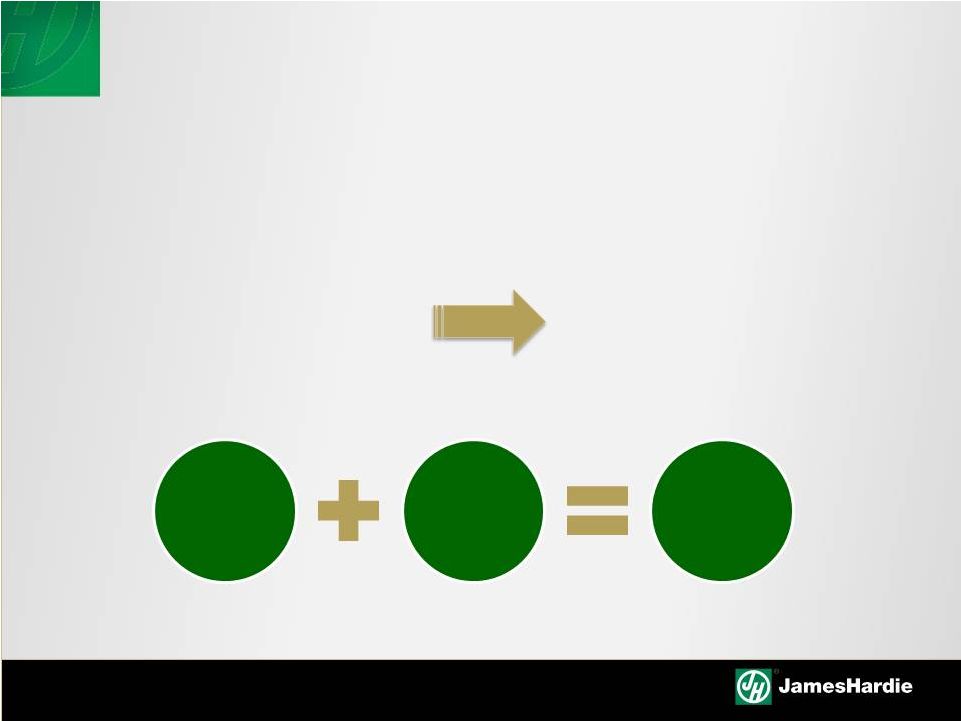 R&D OVERVIEW
JH Business Impact
7
Focus
Results
Capability
JH R&D’s Key Strengths
Dynamic Capability
Evolves
further
–
technology
advantage
FC Centric Focus
People
Execution |
 DYNAMIC CAPABILITY
R&D Overview
JH Business
Impact
Focus
Capability |
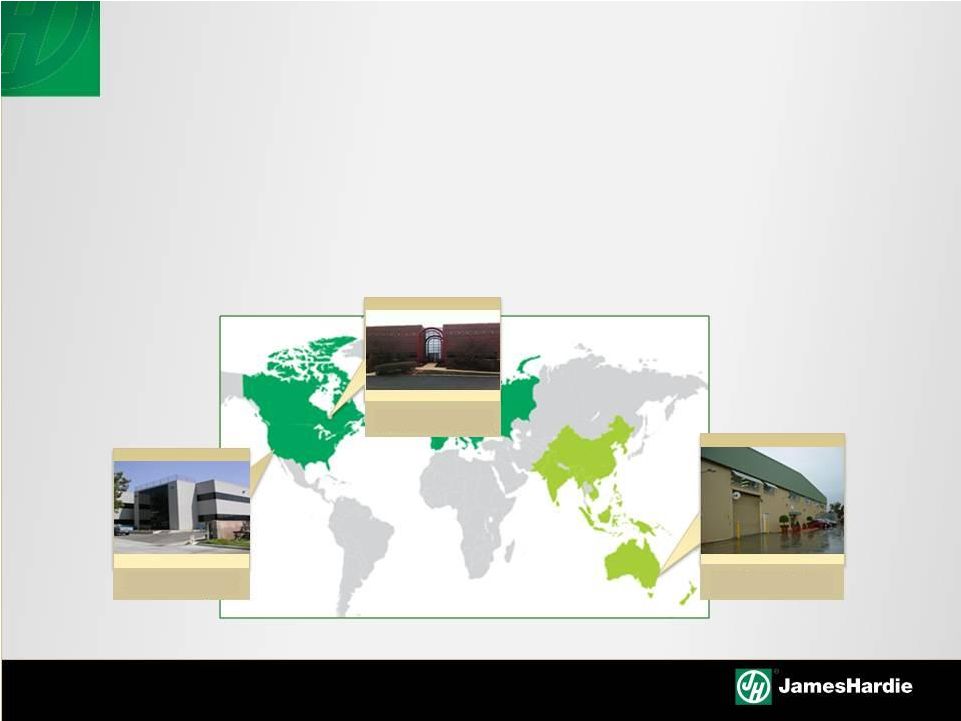 Fontana, CA
Naperville, IL
Sydney, NSW
R&D LOCATIONS
9
Three
research
centers
–
US
and
Australia
•
Fontana, CA
•
Naperville, IL
•
Sydney, NSW |
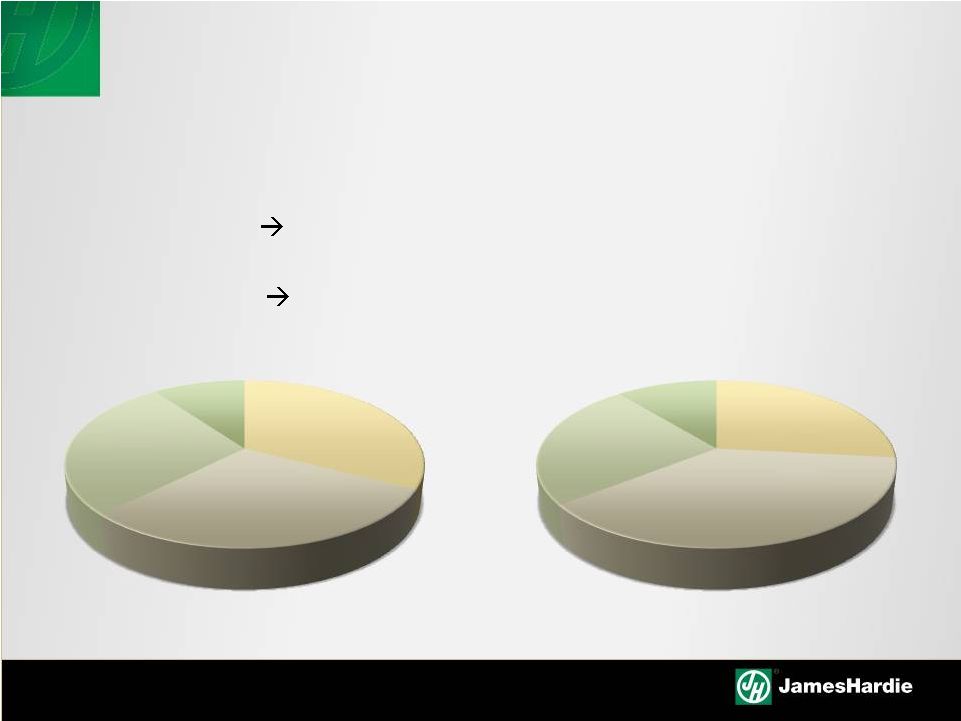 Diverse workforce of 130+ technologists
•
Scientists
Chemistry, Materials, Inorganic, Composite, Wood
& Fibers and Building Science
•
Engineers
Chemical, Mechanical, Electrical, Civil and
Environmental
R&D RESOURCES
~60% have PhD or Master’s Degree
~70% with greater than 6 years service
10
Bachelor's
32%
Master's
30%
PhD's
28%
Others
10%
0-5 Yrs
27%
6-10 Yrs
37%
11-15 Yrs
25%
16+ Yrs
11% |
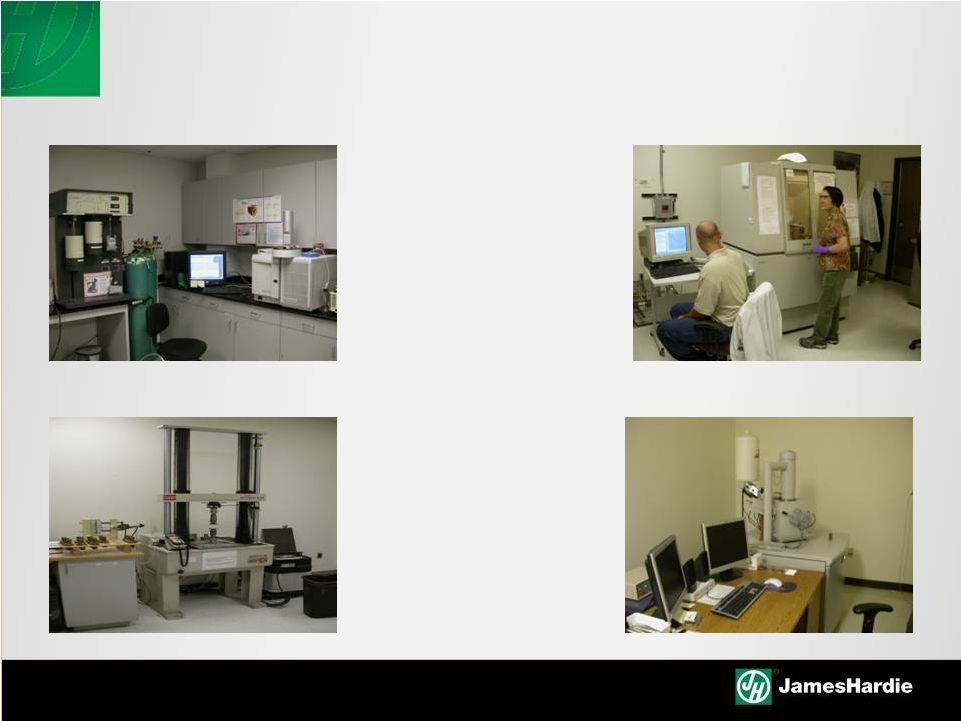 RESEARCH CAPABILITIES
Thermal
Properties
Compositional
Analysis
Mechanical
Properties
Microscopy
11 |
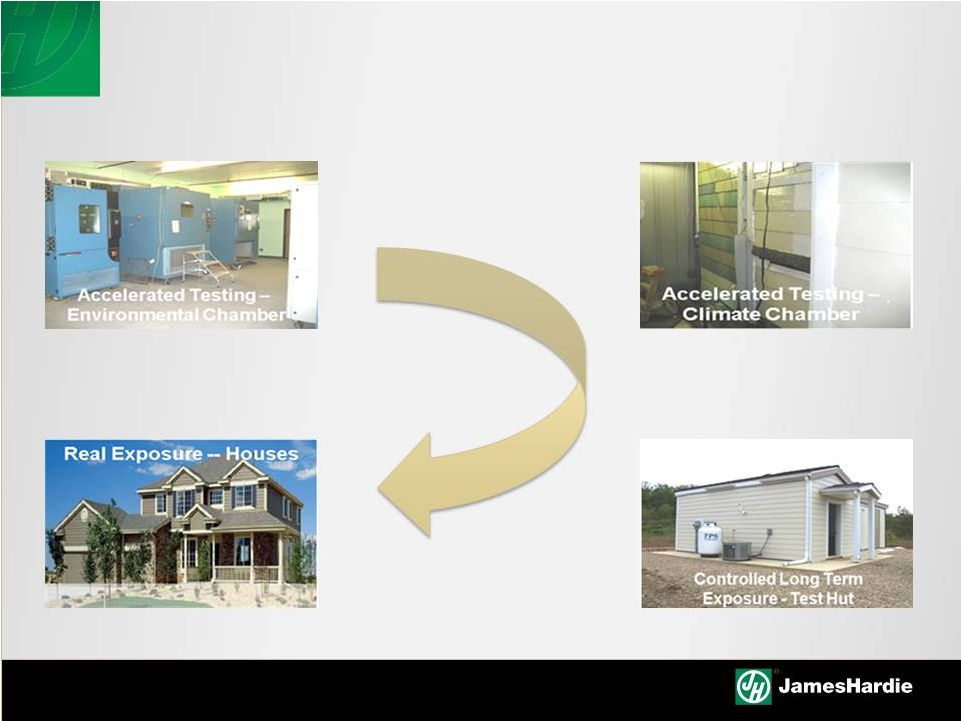 RESEARCH CAPABILITIES
Longer-Term,
Real-Life
Exposure
12 |
 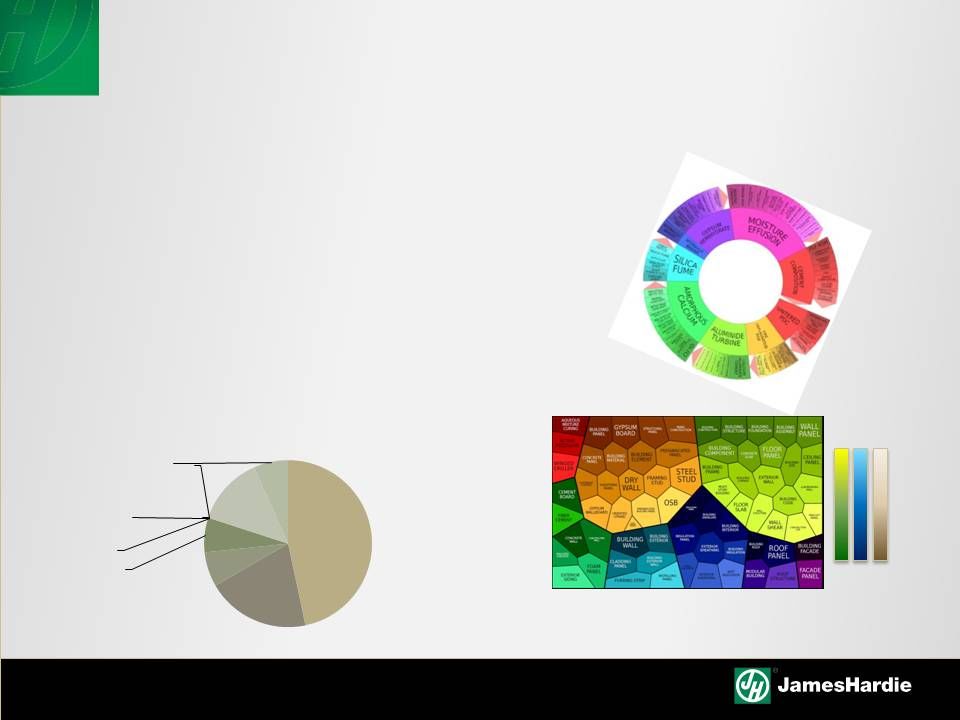 Innovation tools
•
3D printing prototypes (Faster concepts)
•
Pilot processes (Concept investment)
Intellectual property
•
Idea generation process
•
Focused approach on opportunities
INNOVATION CAPABILITY
13
IP Tools (IP Space Availability)
Crowded
IP Space
IP Space
Available
All FC siding
Coatings
Durability
NT3
Tech
Hatscheck
0%
LDA
0%
Non FC
0%
Tools &
0%
New Platforms
New Tech
FY15 IP Concepts YTD
Accessories |
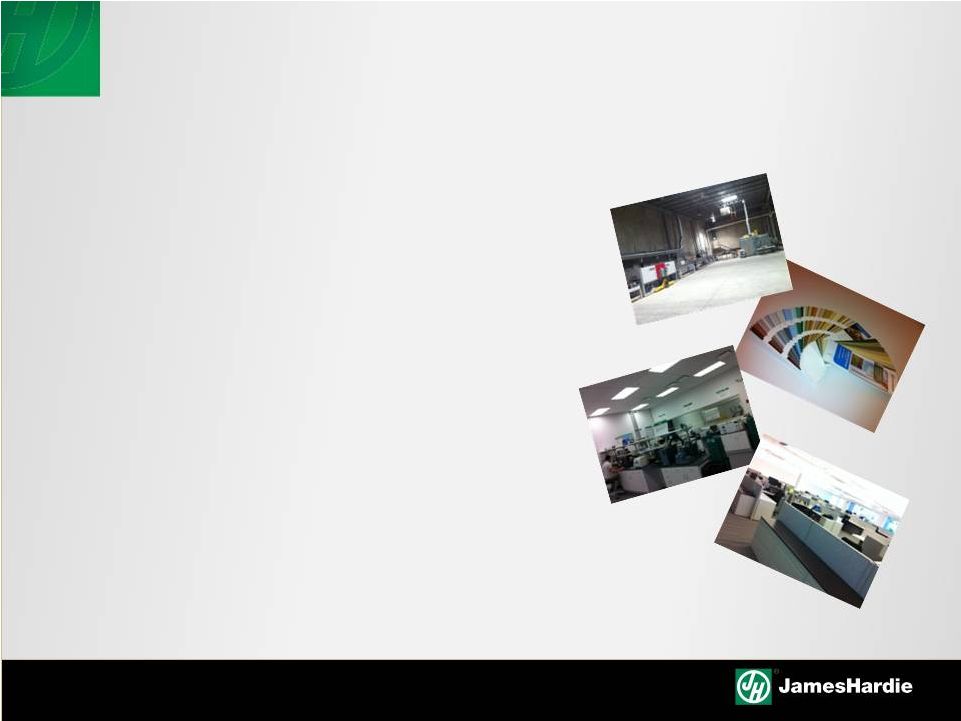 Chicago R&D is operational from Q4
FY13, focusing mainly on non–FC
development
•
Product Development
•
Non-FC materials characterization
•
Product and system testing
•
Pilot lines
Currently capable to develop and
implement non-FC technology initiatives
aligned with business needs
NON–FC CAPABILITY
14 |
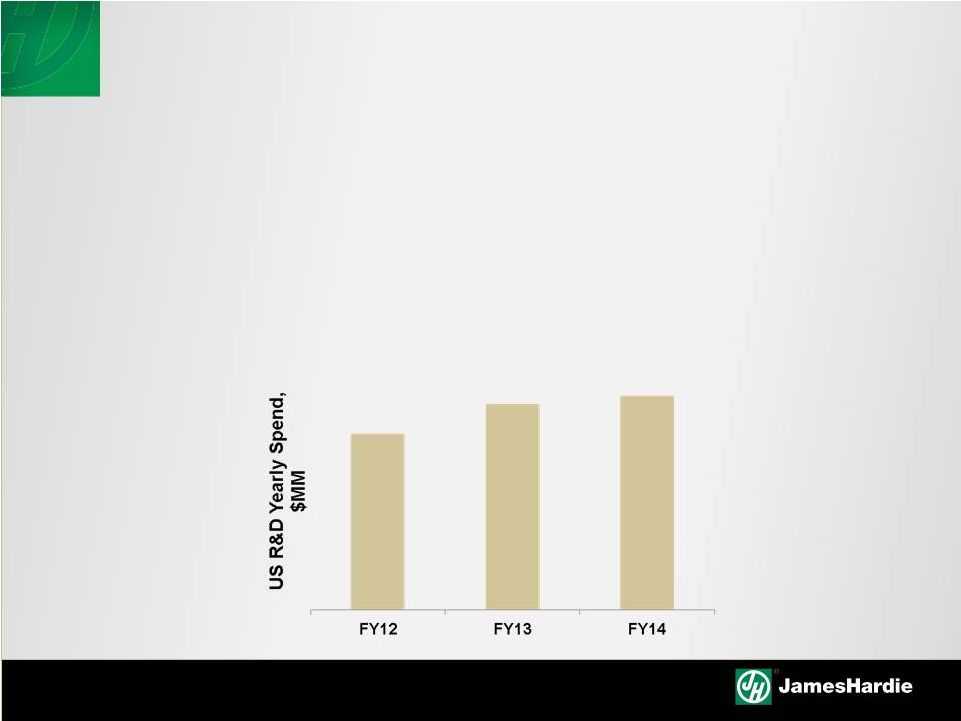 R&D yearly spend is divided between research
and development projects
Research
–
Core
understanding
of
technologies
and
science
behind
them
Development
–
Focus
around
implementing
new
technology
and
new
products
R&D SPEND
15 |
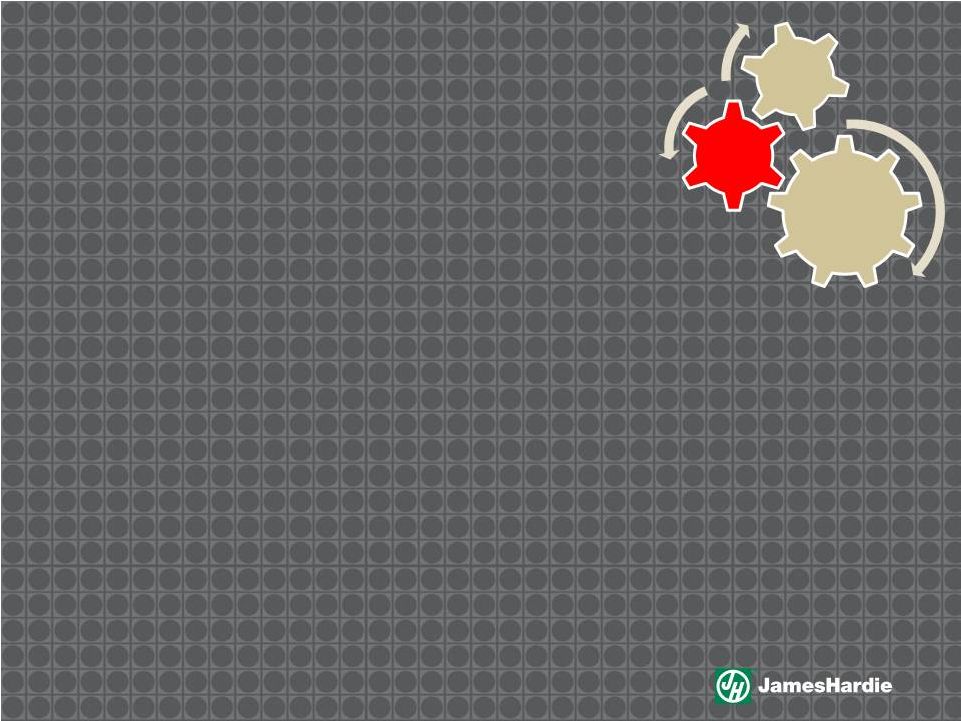 FC
CENTRIC FOCUS R&D Overview
JH Business
Impact
Focus
Capability |
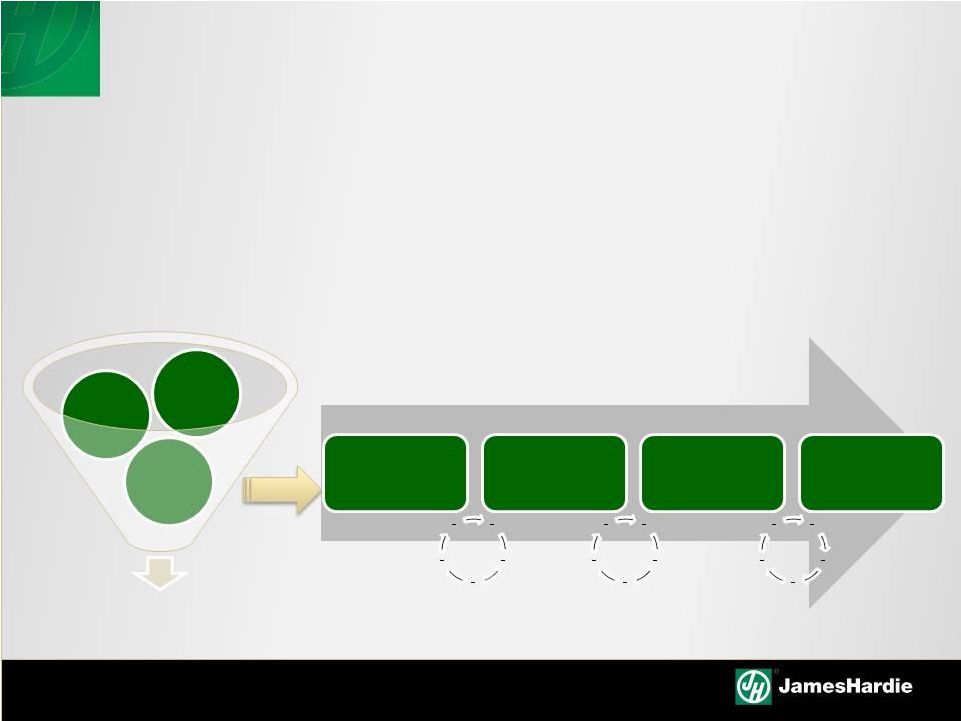 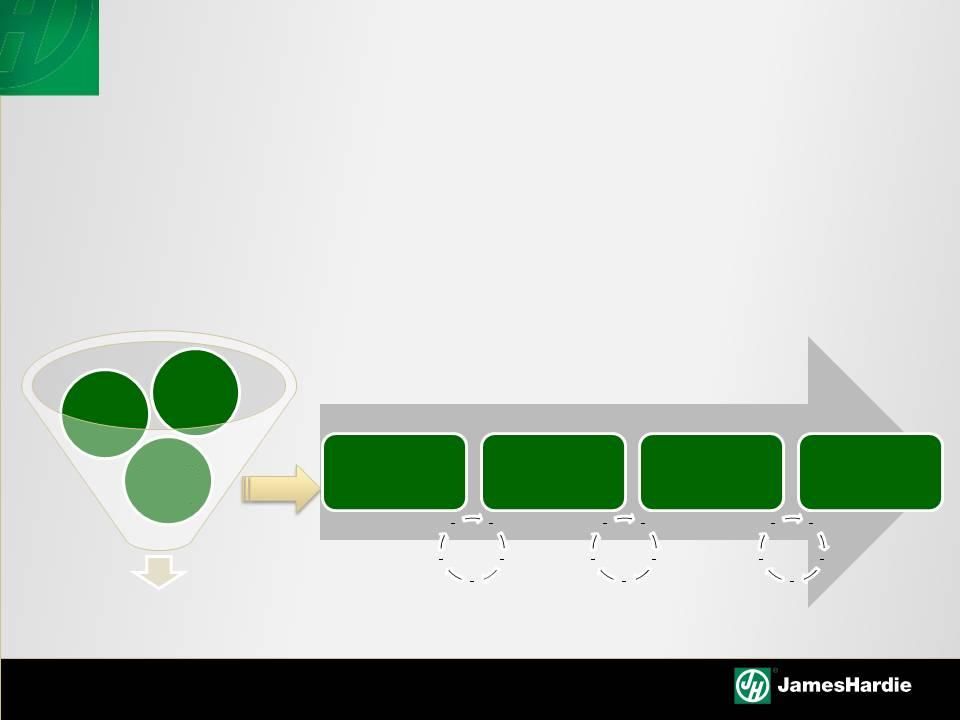 Enable
effective development and implementation of key initiatives Ensure continuous
pipeline of new concepts and ideas JH INNOVATION PROCESS
17
Decision to
Develop
Decision to
Implement
Transfer to
BAU
Feasibility
Development
Implementation
Post
Implementation
What Problem is this
Solving?
Feedback
Loop
Business
Need
Business
Strategy |
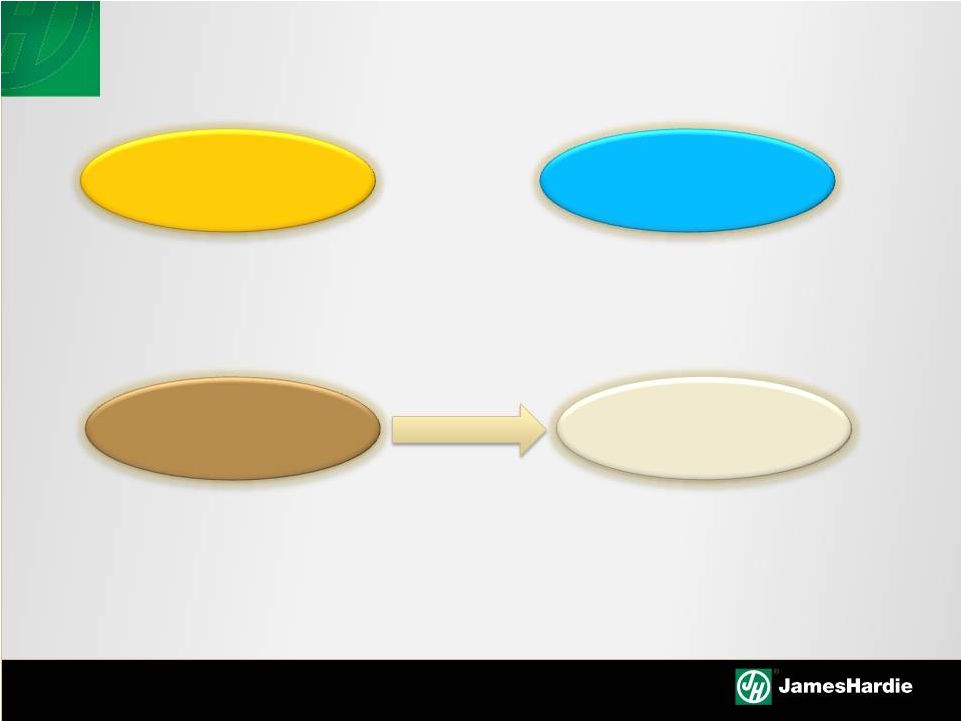 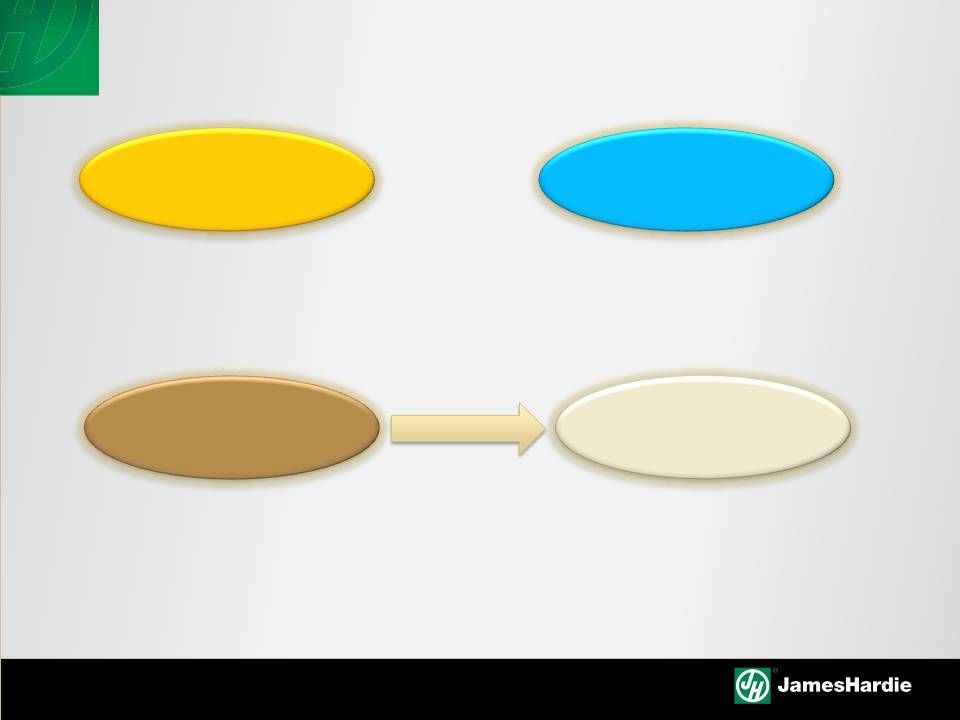 FC
STRATEGIC PRIORITIES 18
Product
Performance
New Product
Development
Platform
Development
Technical Support
•
Substrate Development
•
Coatings Development
•
Raw Materials Formulation
•
Test Method Development
•
Trim/Shapes
•
ColorPlus®
Development
•
Reveal®
•
Top of the Market Products
•
Foam-back Plank
•
Product Form
•
Product Aesthetics
•
Advanced Finishing
•
Concealed Fastening
•
Best Practices/Install
•
Raw Material Sourcing
•
Manufacturing Process Optimization
•
Yield Improvements
ENABLERS |
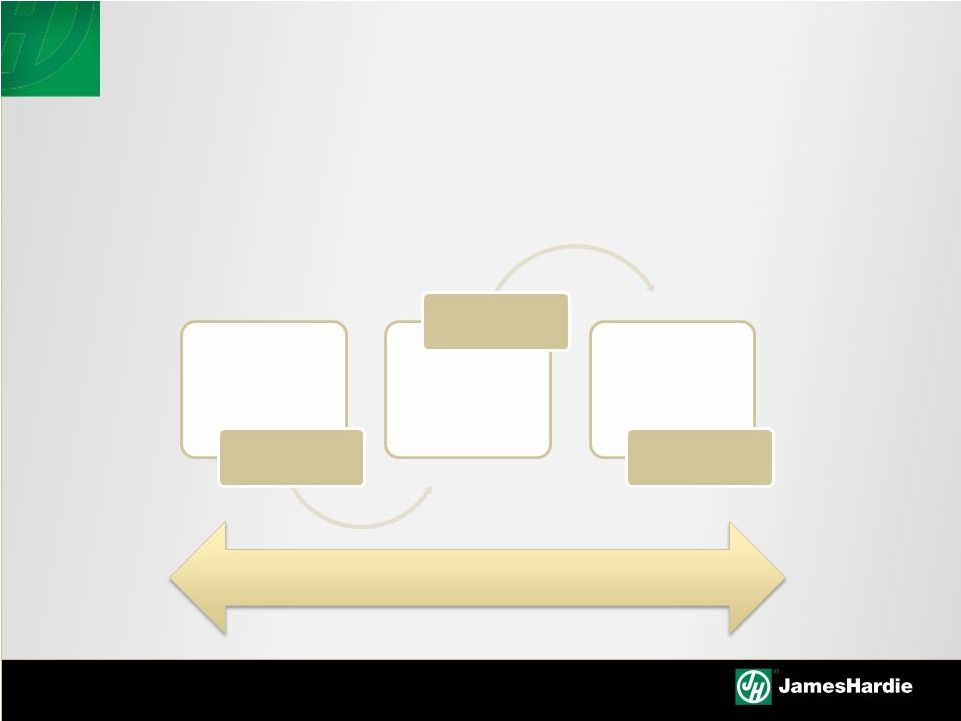 Multi-faceted approach to product performance
PRODUCT PERFORMANCE APPROACH
19
Product Performance
•
Material
Composition
•
Product
Formation
•
Raw Material
Selection
•
Raw Material
Interaction
•
Primers
•
Top Coat
Formulation
Substrate
Coatings |
 Raw
material research is an important aspect of product performance and technical
support strategies Enhance product performance
•
Raw material selection
•
Formulations
Technical support
•
Secure
supply
–
pulp,
cement,
silica
et
al.,
-
Raw material sourcing / New formulations
•
Ensure quality
-
Consistent supply / Universal specifications
•
Improve utilization
RAW MATERIAL FOCUS
20 |
 James Hardie uses low density functional additives for:
•
Lighter / Thicker products
•
Ease of use
•
Performance
Our strategy is to reduce dependency on commercial additives to
in-house technology substitutes
LOW DENSITY ADDITIVES
21
Interiors
Exteriors
HZ10®
Siding
Exteriors
HZ5®
Siding
Low
Density
(LD)
LD
Options
LD
Additive
A
LD
Additive
D
LD
Additive
C
LD
Additive
B |
 Invest in new manufacturing platforms to enable step-
change products in current or new category
PLATFORM DEVELOPMENT FOCUS
22
Platform A
(Current)
Plank
/ Panel
Flat sheets
Higher
throughput
Platform B
(Current)
Thicker
products
Functional
Platform C
(New)
Aesthetics
Product
Form
High-end
products
Platform D
(New)
Shapes
Extreme
applications
Functional |
 Balanced mix of step change products and product line
extensions to drive JH category and market share growth
PRODUCT DEVELOPMENT FOCUS
23
Form
Aesthetics
Texture
Shape
Weight
Color
Function
Water
management
Durability
Energy
efficiency
Concealed
fastening
Nail line
Ease of
install
Features |
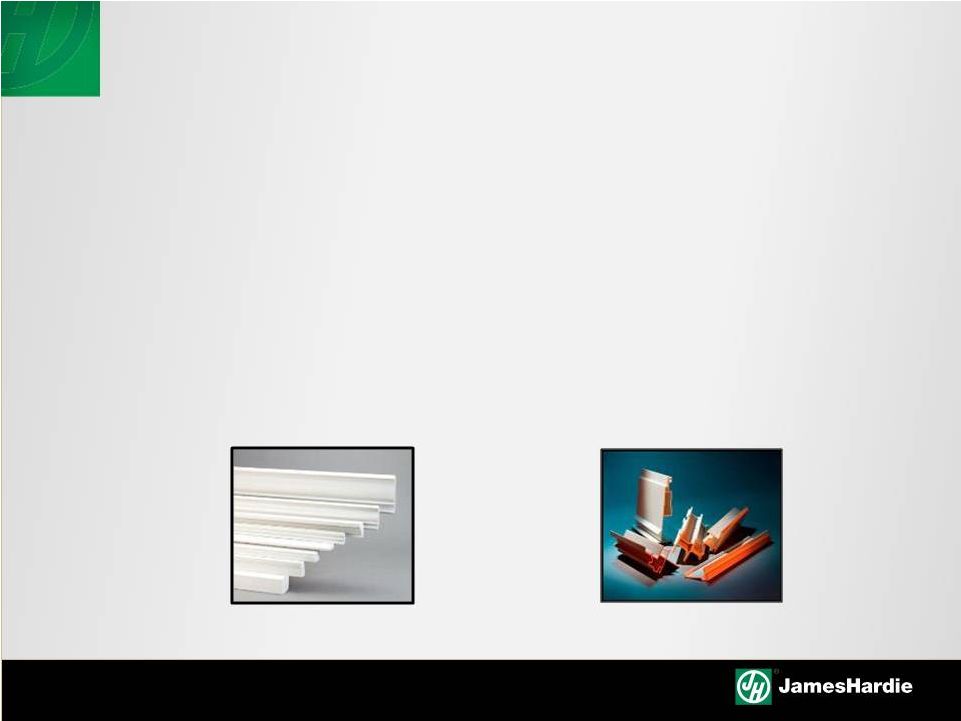 Evaluate and develop non–FC technologies for fit with
current and future JH business
Mouldings
–
Provide shapes to complement JH FC trim portfolio
Windows
–
Develop non-FC technology as an entry vehicle into
NON–FC STRATEGIC PRIORITIES
24
fiber glass windows |
 JH
BUSINESS IMPACT R&D Overview
JH Business
Impact
Focus
Capability |
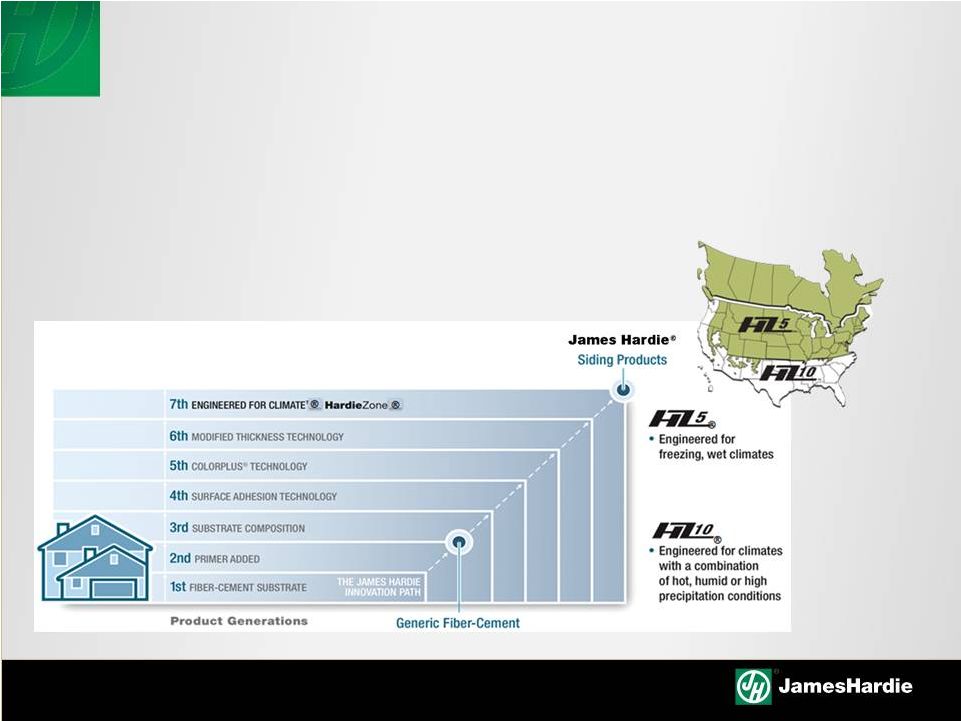 Delivered HardieZone
®
Engineered for Climate
®
Products
7
th
Generation of FC products
HARDIEZONE
®
–
ENGINEERED
FOR
CLIMATE
®
26 |
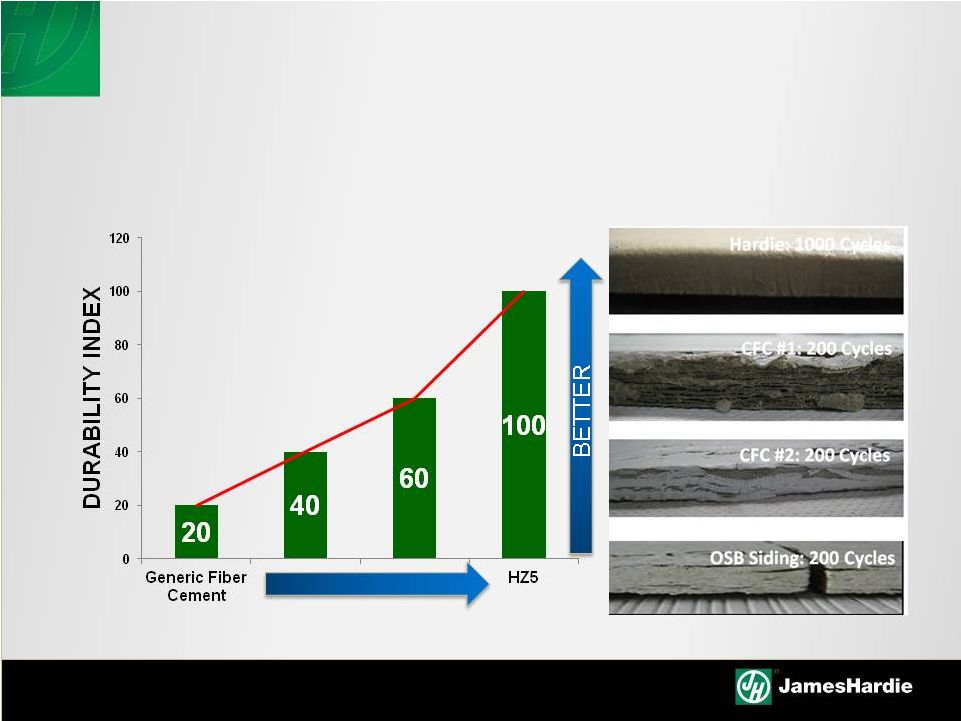 HZ5
®
siding performs 5x better than generic FC in system testing
PRODUCT PERFORMANCE
27
Source: James Hardie Internal Research and Testing
TIME |
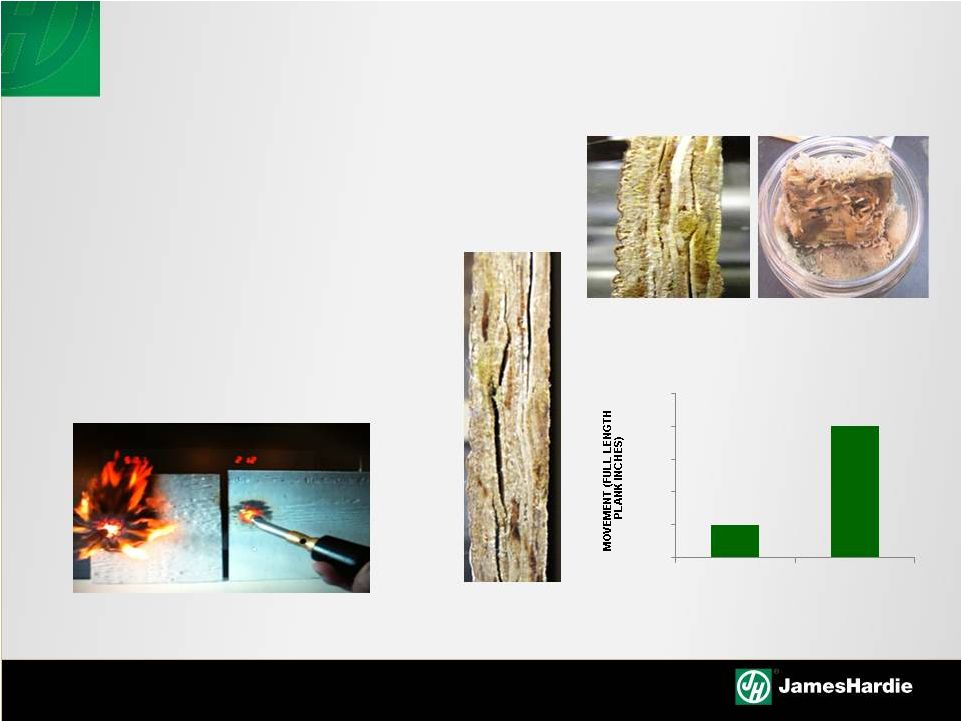  JH vs.
COMPETITORS (OSB / Hardboard) 28
Like Hardboard, OSB siding is a wood based,
manufactured product that can experience similar
issues when exposed in external applications :
Source: James Hardie Internal Research and Testing
Termite Activity
Splitting
Fire
Mold Growth
Moisture Movement
JH
OSB
1/16
1/4
0
1/16
1/8
3/16
1/4
5/16
JH
OSB
Real World Movement
is 4X, Damp to Ambient
•
Fire
•
Splitting
•
Mold Growth
•
Termites
•
Significant Moisture Movement
•
Swelling |
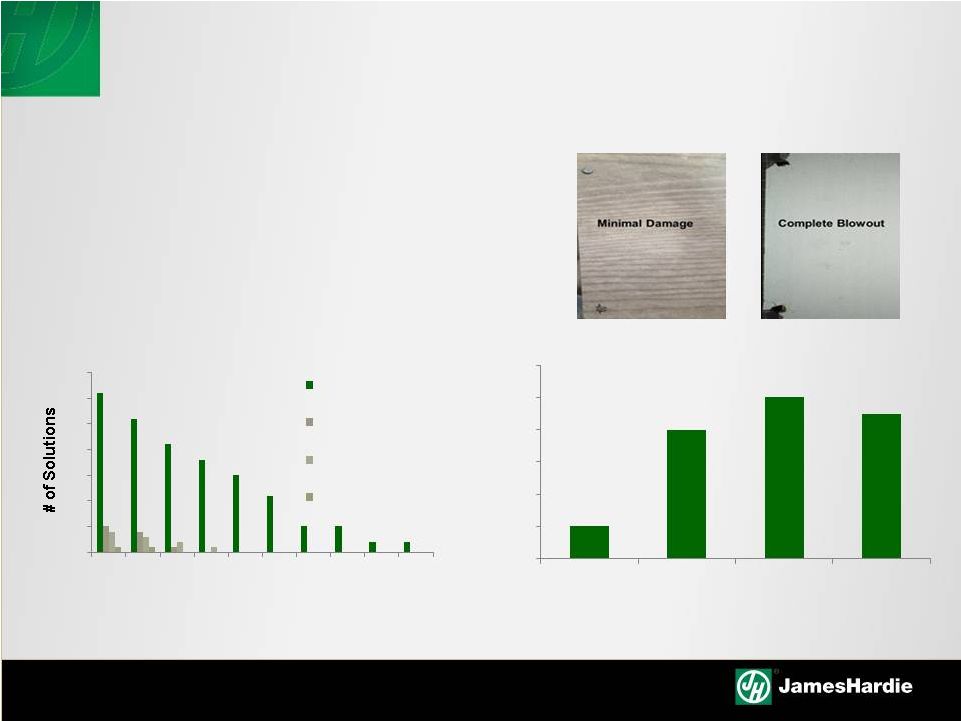 JH
vs. COMPETITORS (CFC) 29
Competitive Fiber Cement Siding
Source: James Hardie Internal Research and Testing
JH
CFC
Nailing
Brittleness (Lower the Better)
Source: External Code Compliance Reports (ICC-ES)
0
5
10
15
20
25
30
35
110
120
130
140
150
160
170
180
190
200
Wind Speed (mph)
# Blind Nail Solutions
(Exp. Cat D @ 30ft.)
HardiePlank®
Siding
CFC #1
CFC #2
CFC #3
0
1
2
3
4
5
6
JH
CFC #1
CFC #2
CFC #3
•
Low quality raw materials
•
More brittle, nailing damage
•
Few approved wind load solutions
•
High movement (moisture)
•
Poor paint and primer adhesion |
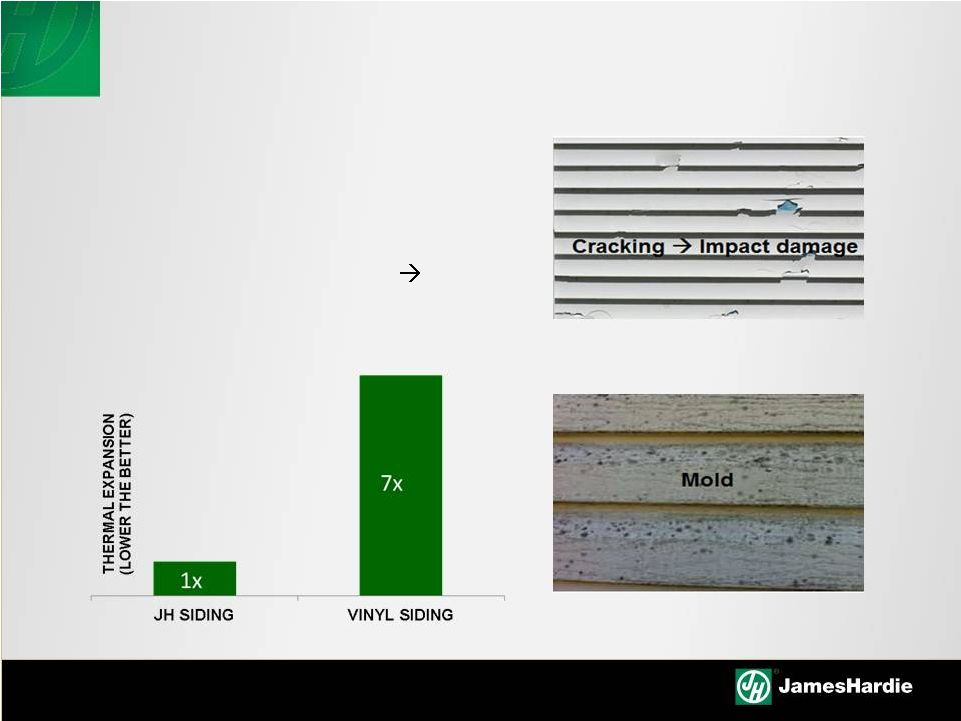 JH
vs. COMPETITORS (Vinyl) 30
Vinyl / PVC Siding
Source: James Hardie Internal Research and Testing
•
Looks cheap
•
Relatively durable but can melt even
from reflected light (low-e window)
•
Very high thermal movement
7x
compared to JH
•
Poor impact resistance |
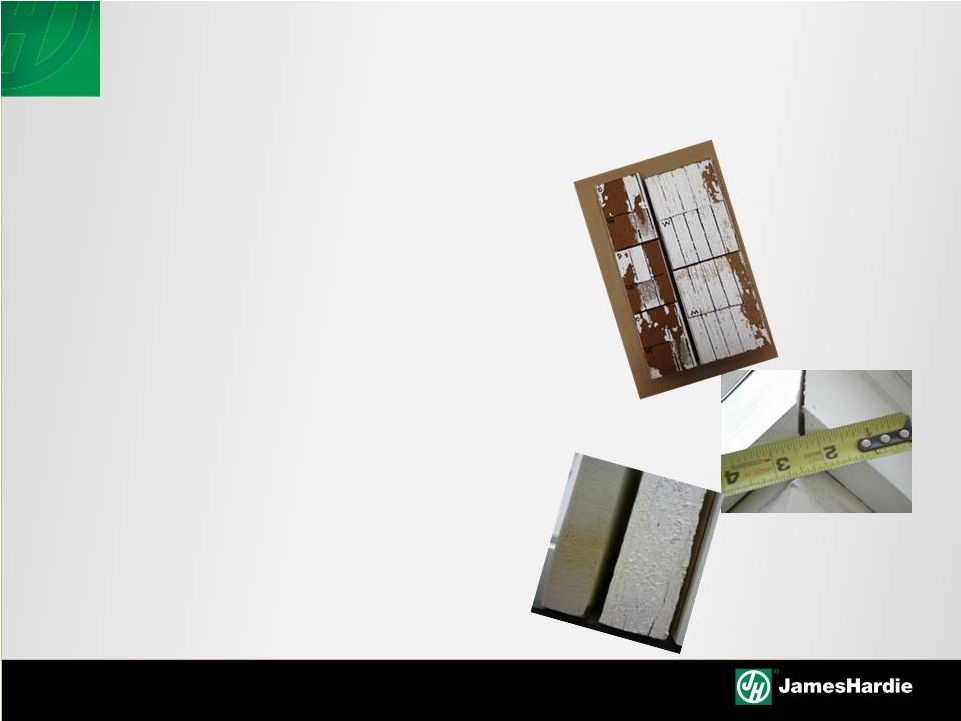 •
OSB / Hardboard trim
•
Poor paint adhesion
•
Low resistance to mold
•
High water absorption and swelling
•
PVC trim
•
High thermal expansion (7x)
•
High movement / High gapping
•
Low thermal stability / Yellowing
•
Polyurethane composite trim
•
High thermal expansion (3x)
•
Low UV resistance (PU)
•
Poor paint adhesion
JH vs. COMPETITORS (Trim)
31
Paint Adhesion –
OSB / Hardboard
Gapping -
PVC
Swelling –
OSB /
Hardboard
Source: James Hardie Internal Research and Testing |
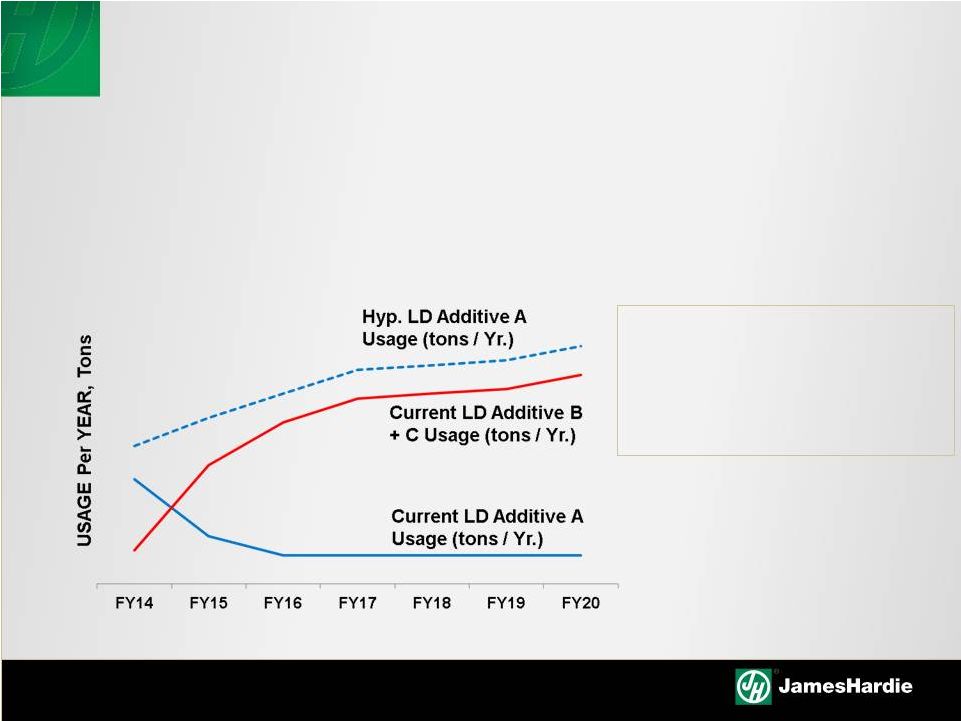 By
focusing on low density research, JH was able to reduce the dependency on
commercial additives to in-house technology substitutes
LOW DENSITY ADDITIVES
32
This Enables:
•
Lighter / Thicker products
•
Cost –
effective, Durable products
•
Reliable supply of raw material |
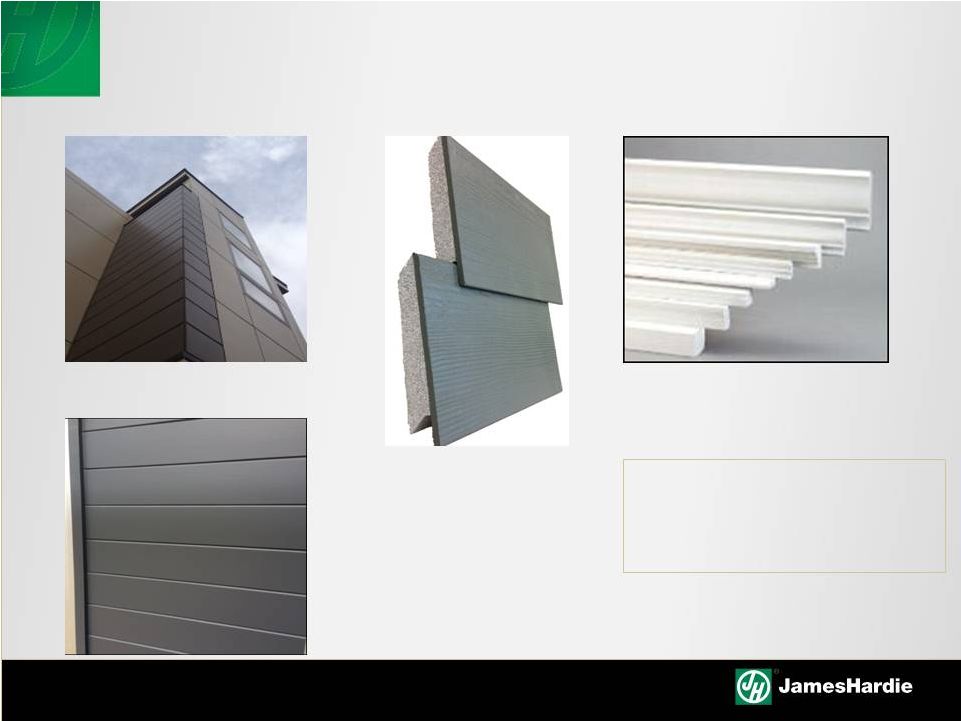 PRODUCT DEVELOPMENT
33
Other Products
•
Trim extensions
•
Shingle extensions
•
High-end panel extensions
HardieReveal2.0™Panel
System
HardiePlank® Lap
Siding with Insulation
HardieTrim™ Mouldings
Artisan® V-Rustic
Siding |
 In
summary, JH R&D has enabled •
Impact on product performance
•
Product leadership compared to competitors
•
Impact on raw materials and low density materials
•
Product and platform development
•
Better innovation
STRONG JH BUSINESS IMPACT
34 |
  SUMMARY
R&D Overview
JH Business
Impact
Focus
Capability |
 KEY
TAKEAWAYS James Hardie R&D invests and functions towards:
Ensuring Product Performance
•
JH products demonstrate superior durability compared to the
competition
Maintaining Product Leadership
•
Differentiated products are being created to enable future PDG vs.
wood and vinyl options
Enabling Platforms
•
New platforms are being developed to enable future business growth
36 |
 R&D FUTURE DELIVERABLES
Continue Research and Development of Key Technology Strategies
•
Product Performance
•
Raw Materials
•
Low Density
Continue Investments of Key Platform Strategies
Continue to Deliver New Products
Aligned with Corporate Strategy
•
Act
as
the
technology
pipeline
for
JH
and
deliver
key
results
towards
JH’s overall category and market share growth strategy
37 |
 QUESTIONS
R&D Overview
JH Business
Impact
Focus
Capability |